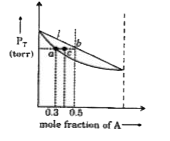A metal crystalizes into two cubic phases, face centred cubic (FCC) and body centred cubc (BCC), whose unit cell lengths are 3.5 and 3.0A∘, respectively. Calculate the ratio of densities of FCC and BCC.Solution in Malayalam
1.259
12.59
0.259
0.0259
The correct Answer is:A
Density, d=z×Formula mass of substanceN0×a3
Since for FCC, z=4and for BC,z=2
dFCC=4×Formula mass of metalN0×(3.5)3anddBCC=2×Formula mass of metalN0×(3)3
Dividing dFCCanddBCC,dFCCdBCC=42×(3)3(3.5)3=2×0.6297=1.259
Topper's Solved these Questions
- BOOK - BRILLIANT PUBLICATIONCHAPTER - SOLID STATEEXERCISE - LEVEL-310videos
SOLID STATE
- BOOK - BRILLIANT PUBLICATIONCHAPTER - SOLID STATEEXERCISE - LEVEL-3 (Multiple Correct Answer Type)13videos
SOLID STATE
- BOOK - BRILLIANT PUBLICATIONCHAPTER - SOLID STATEEXERCISE - LEVEL-150videos
SOLID STATE
- BOOK - BRILLIANT PUBLICATIONCHAPTER - REDOX REACTION & ELECTROCHEMISTRYEXERCISE - QUESTION (ELECTROCHEMISTRY) (LEVEL -II) (ASSERTION-REASON)3videos
REDOX REACTION & ELECTROCHEMISTRY
- BOOK - BRILLIANT PUBLICATIONCHAPTER - SOLUTIONSEXERCISE - Level-III (Linked Comprehension Type)12videos
SOLUTIONS
Similar Questions
The unit cell length of NaCl is observed to be 0.5627 nm by X-ray diffraction studies, the measured density of NaCl is 2.164 g cm−3. Calculate % of missing Na+andCl− ions.
03:44View SolutionWhich of the following statements are correct ?
03:44View SolutionThe radius of a di val ent cation M2+ is 94 pm and of divalent anion X2− is 146 pm. Thus, M2X2− has
03:44View SolutionAssertion: After the electrolysis of aqueous CuSO4 solution pH decreases.
Reason: Sulphuric acid is formed.03:44View Solution1 mole of A and 1 mole B are mixed together to form an ideal solution at 25∘C. Solution is placed in a vessel fitted with piston. If pressure on the solution is reduced isothermally.

Correct relationship between P∘AandP∘B is03:44View SolutionA metal crystallizes into two cubic phases, face-centred cubic and body-centred cubic, which have unit cell lengths 3.5 and 3.0A, respectively. Calculate the ration of densities of fcc and bcc.
View SolutionA metal crystallizes into two cubic phases, face-centred cubic and body-centred cubic, which have unit cell lengths 3.5 and 3.0A, respectively. Calculate the ration of densities of fcc and bcc.
03:25View SolutionA metal crystallizes into two cubic phases, face-centred cubic and body-centred cubic, which have unit cell lengths 3.5 and 3.0A, respectively. Calculate the ration of densities of fcc and bcc.
03:44View SolutionA metal crystallises into two cubic phases , face-centred cubic (FCC) and body-centred cubic (BCC) whose unit cell lengths are 3.5 and 3.0 Å respectively. Calculate the ratio of the densities of FCC and BCC
04:19View SolutionA metal crystallizes into two cubic phases , face-centred cubic (fcc) and body -centred cubic (bcc) whose unit cell lengths are 3.5 and 3.0 Å respectively. Calculate the ratio of the densities of fcc and bcc.
04:33View SolutionA Metal crystallises into two cubic faces namely face centered (fcc) and body centered (bcc). Whose unit cell edge length are 3.5Å respectively .Find the ratio of the densities of fcc and bcc.
06:38View SolutionA metal crystallizes into two cubic systems - face centred cubic (fcc) and simple cubic (SC), whose unit cell lengths are 4.5Å and 1.501Å respectively. Calculate the ratio of densities of face centred cubic and Simple cubic.
02:30View SolutionA metal crystallizes into two cubic phases, face-centred cubic and body-centred cubic, which have unit cell lengths 3.5 and 3.0A, respectively. Calculate the ration of densities of fcc and bcc.
05:22View Solutionएक धातु फलक केंद्रित घन (face centred cubic , fcc ) तथा अन्तः केंद्रित घन (body centred cubic, bcc ) , दोनों रूपों में क्रिस्टलीकृत होती है , जिनमें इकाई सेल की भुजा की लम्बाई क्रमश :4.5 तथा 4.0Å है। fcc तथा bcc के घनत्वों के अनुपात की गणना कीजिए।
03:19View SolutionA metal crystallise into two cubic phases FCC and BCC whose unit cell lengths are 2.5 and 2.0 A^0 respectively, the ratio of densities of BCC and FCC
05:40View Solution

